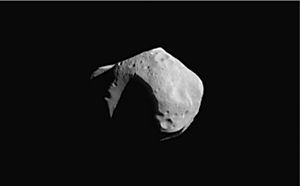253 Mathilde facts for kids

NASA image of 253 Mathilde
|
|
| Discovery | |
|---|---|
| Discovered by | Johann Palisa |
| Discovery date | November 12, 1885 |
| Designations | |
| A915 TN; 1949 OL1 | |
| Main belt | |
| Orbital characteristics | |
| Epoch January 30, 2005 (JD 2453400.5) | |
| Aphelion | 501.334 Gm 3.35121 AU |
| Perihelion | 290.564 Gm 1.94230 AU |
| 395.949 Gm 2.64676 AU |
|
| Eccentricity | 0.266157 |
| 1572.787 d (4.31 yr) |
|
|
Average orbital speed
|
17.98 km/s |
| 111.960° | |
| Inclination | 6.738° |
| 179.633° | |
| 157.475° | |
| Physical characteristics | |
| Dimensions | 52.8 km (66×48×46 km) |
| Mass | 1.033(±0.044)×1017 kg |
|
Mean density
|
1.3 g/cm³ |
| 0.0025 m/s² | |
| 16.2 m/s | |
| 17.406±0.010 d (17 d 9 h 45 min) |
|
| Albedo | 0.0436 |
| Temperature | ~174 K |
|
Spectral type
|
Cb |
| 10.20 | |
253 Mathilde is a space rock called an asteroid. It orbits the Sun in the main asteroid belt. Johann Palisa discovered it way back in 1885.
This asteroid has a long, oval-shaped path around the Sun. It takes more than four years to complete one trip. Mathilde spins very slowly, taking over 17 days to turn around once. Its surface is very dark because it has a lot of carbon. It reflects only about 4% of the sunlight that hits it.
In June 1997, a spacecraft named NEAR Shoemaker flew past Mathilde. It was on its way to another asteroid called 433 Eros. The spacecraft took many pictures of one side of Mathilde. It found huge holes called craters on its surface. Mathilde is the biggest asteroid a spacecraft has ever visited. It was also the first dark, carbon-rich asteroid to be explored up close.
Contents
What is 253 Mathilde Like?

253 Mathilde is known for being very dark. It has many giant craters on its surface. These craters are named after famous coal fields around the world.
The two biggest craters are Ishikari and Karoo. Ishikari is about 29.3 kilometers wide. Karoo is even bigger, at 33.4 kilometers wide. These craters are almost as wide as the asteroid itself! The way they look suggests that big impacts might have broken off large parts of the asteroid.
Is Mathilde a Rubble Pile?
Scientists measured Mathilde's density using the NEAR Shoemaker spacecraft. They found it is very light for its size. This low density suggests that Mathilde might be a "rubble pile."
Imagine a pile of loose rocks and dust. That's what a rubble pile asteroid is like. It means the asteroid was broken apart by a collision. Then, its own gravity pulled the pieces back together loosely. Up to half of Mathilde's inside might be empty space!
However, there's a long cliff-like feature, about 20 kilometers long. This might mean the asteroid has some stronger parts inside. It's not just a completely loose pile.
Mathilde's Orbit and Rotation
Mathilde's orbit is quite stretched out. It travels to the outer parts of the main asteroid belt. But don't worry, its path stays safely between the orbits of Mars and Jupiter. It never crosses the paths of these planets.
Mathilde spins very slowly. Most asteroids spin much faster, usually in a few hours. Because Mathilde spins so slowly, the NEAR Shoemaker spacecraft could only take pictures of about 60% of its surface. Scientists thought a small moon might be orbiting Mathilde and slowing it down. But the spacecraft didn't find any moons bigger than 10 kilometers.
Images for kids
See also
 In Spanish: (253) Mathilde para niños
In Spanish: (253) Mathilde para niños



